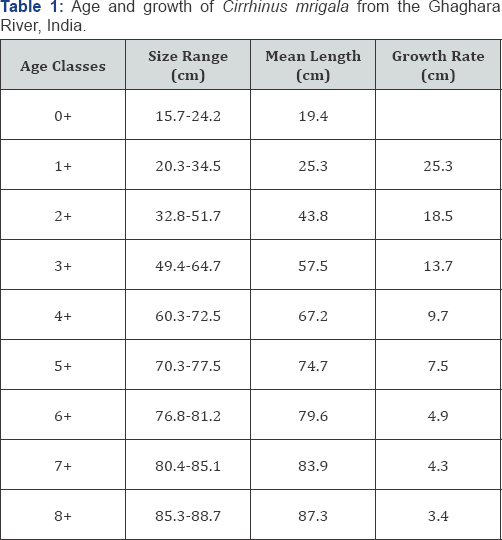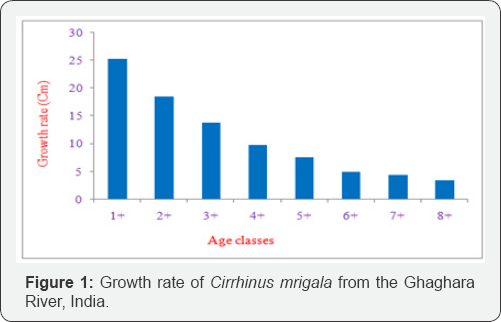Stressors Altering the Size and Age of Cirrhinus mrigala (Hamilton, 1822) from the Ghaghara River, India- Juniper Publishers
Juniper Publishers- Journal of Oceanography
Abstract
Human activities have been widely accepted as a driver of rapid trait change in wild fish stock globally with help of stressors. Fishing and invasive species are among the most important stressors which are affecting freshwaters fish stock from the lotic and lentic ecosystem. Study was carried out between the periods November 2015 to October 2016 from the Ghaghara river at Faizabad, India. The age composition of C. mrigala varied from 0+ to 8+ from the Ghaghara river at Faizabad. On the basis of sampled specimen in the length range from 15.7 to 88.7cm showed that the fish attained the mean length 25.3cm in 1+, 43.8cm in 2+, 57.5cm in 3+, 67.2cm in 4+, 74.7cm in 5+, 79.6cm in 6+, 83.9cm in 7+ and 87.3cm in 8+ age classes. The growth increments of C. mrigala was recorded as 25.3cm, 18.5cm, 13.7cm, 9.7cm, 7.5cm, 4.9cm, 4.3cm and 3.4cm for 1+ to 8+ age classes, respectively. The maximum growth increment was estimated in 1st year and moderate in the subsequent years.
Keywords: Stressors; Age and growth; Cirrhinus mrigala; Invasive species; Ghaghara river; Anterior field (AF); Posterior field (PF); Lateral fields (LF); Focus (F)
Introduction
Cirrhinus mrigala (Hamilton, 1822) is a member of Indian major carp group [1,2]. C. mrigala is a natural inhabitant of the Indus and Ganga river systems [3]. It is commercially exploited from the Ganga and Yamuna rivers in group of Indian major carp [4-6] and Ghaghara river [7,8]. The natural distribution of C. mrigala is in the freshwaters of northern India, Bangladesh, Burma and Pakistan. It was introduced into south Indian waters where it has been established well [9]. C. mrigala was transplanted to Andman Islands in 1920s and it has now become a common fishery in the Island. Along with other Indian major carps C. mrigala had also been successfully transplanted to Nepal, Malayasia, Sri Lanka, Japan, Mauritus, Philippines, South Rodesia, U.S.S.R., Africa, Vientiena, etc. from Calcutta since 1957 onwards and is reported to have been established well in some of those countries [9]. It is an excellent species for pond culture. The species has been transplanted successfully from the natural range within India and to parts of Asia as well as Europe [10,11].
Freshwater ecosystems touch nearly all aspects of human society [12]. Fishing, anthropogenic and invasive species are among the most important stressors which are affecting freshwaters fish stock from the lotic and lentic ecosystem (e.g. streams, rivers, canals and reservoirs) [13-16] with significant ecological and economic impacts [17-21]. About 65% of inland habitat is classified as moderately or highly threatened by anthropogenic stressors [4,22]. Fishing stressors associated with net and mesh size and nature of fishing [23]. There is a long history of introduction of non-native fishes in fresh waters and the introduction rate has accelerated greatly over time. Large size fishes and economically important fishes are targeted fished by fishermen community from rivers [24,25].
Stressors have strongly altered size, age and growth of fishes from the freshwater ecosystems over the world. Fish respond directly to some environmental stressors such as toxic and thermal pollution, flow regime change, and climate change Dudgeon et al. [26]. Fish also respond indirectly to stressors that impact their environment. The present study was thus undertaken to estimate age and growth increment of C. mrigala in respect of stressors from the Ghaghara River at Faizabad, India. This study will help in formulation the fishery management policies of C. mrigala from the Ghaghra River, India.
Material and Methods
The Ghaghara river rises in the southern slopes of the Himalayas in Tibet (Tibetan Plateau near lake Mansarovar), in the glaciers of Mapchachungo, at an elevation of about 3,962 metres (12, 999ft) above sea level. Ghaghara is a perennial transboundary river. It cuts through the Himalayas in Nepal and joins the Sharda River at Brahmaghat in India. Together they form the Ghaghara River, a major left bank tributary of the Ganges. With a length of 507km (315mi) it is the longest river in Nepal. The total length of Ghaghara River up to its confluence with the Ganges at Doriganj in Bihar is 1,080km. It is the largest tributary of the Ganges by volume and the second longest tributary of the Ganges by length after Yamuna.
Study was carried out between the periods November 2015 to October 2016 from the Ghaghara river at Faizabad district, India. The key scales [27] were used for determination of the age and growth of C. mrigala. The key scales were gently removed with fine forceps from the row above lateral line below dorsal fin region (especially 3rd or 4th rows) [28-30]. Immediately after their removal, scales were cleaned mechanically using a fine brush and rinsed with distilled water. The scales were cleaned in 5% KOH solution to remove adhering-tissues and finally washed in distilled water. The scales were then pressed while drying in order to avoid their curling. After proper cleaning of the scales, the counting of growth rings was performed. The age of the fish was determined using Carl Zeiss Jena scale Reader. The ring zone was appeared in opaque format and rest zone was transparent.
Results and Discussion
The stressors i.e. overexploitation, anthropogenic activities and invasive species are dominant from the Ghaghara river. C. mrigala is struggling with Cyprinus carpio for food and feeding ground from the Ghaghara. It is also overexploited from the river. Various fishermen/fishers are exploited this fish as target fishing. Cirrhinus mrigala fishery is disturbed by these stressors from the Ganga and Yamuna rivers, India [31-33]. Few invasive species i.e. C. carpio and Oreochromis niloticus have not follow any rule and regulation in respect of water quality [34-36]. The invasive fish species are a highly nonrandom subset of the freshwater biota [37-38]. The Ghaghara River is exposed to different anthropogenic stressors, including organic and nutrient pollution and contamination with priority and other chemical substances from agriculture and local industries. The various human activities act as stressors in various types of interactions [39-42].
The impacts of invasive species can be immense and sometimes irreversible, and they have significant effects on the ecological, economic, and social health of a region [37]. Invasive species have several characteristics that allow them to become dominant in ecosystems, including their adaptability to a wide range of habitats and conditions, rapid growth rates, prolific reproductive and dispersal capacity, and a lack of natural predators or parasites [43]. Aquatic invasive species are particularly difficult to control because they disperse so readily and their ability to invade new habitats has led to rapid range expansions. C. mrigala possess typical cycloid scales in the body. Hence, scales of these species were similar in structure and consisted of an anterior field (AF), a posterior field (PF), two lateral fields (LF) and a focus (F). The anterior field of the scale remains embedded in the skin, while the posterior field is visible 'in situ' condition.
The age composition of C. mrigala varied from 0+ to 8+ from the Ghaghara river at Faizabad. The size ranges varied from 15.724.2cm, 20.3-34.5cm, 32.8-51.7cm, 49.4-64.7cm, 60.3-72.5cm, 70.3-77.5cm, 76.8-81.2cm, 80.4-85.1cm and 85.3-88.7cm in 0+ to 8+ age classes. On the basis of sampled specimen in the length range from 15.7 to 88.7cm showed that the fish attained the mean length 25.3cm in 1+, 43.8cm in 2+, 57.5cm in 3+, 67.2cm in 4+, 74.7cm in 5+, 79.6cm in 6+, 83.9cm in 7+ and 87.3cm in 8+ age classes (Table 1). The growth increments in C. mrigala was estimated as 25.3cm, 18.5cm, 13.7cm, 9.7cm, 7.5cm, 4.9cm, 4.3cm and 3.4cm for 1+ to 8+ age classes, respectively (Figure 1). The maximum growth increment was recorded in 1st year and moderate in the subsequent years. Further, this fish follows the general growth pattern i.e. the annual increment decreases with the increase in age which is a characteristic feature of most of the carps. The minimum growth increment was recorded in 8th year of the life. The slow growth increment observed after second year may be attributed to the maturity attained after second year of life. It is well known that the growth potential is used for the gonad development.


Estimation of accurate fish age is considered as an essential step for age assessment of fish population and successful resource management [44,45]. Differences in growth may be observed when same species inhabit different rivers of same ecoregion. C. mrigala grows well both in the lentic and lotic environments and performs better growth in the old tank with adequate vegetable debris [9,46]. Jhingran VG [47] reported that the mean length of C. mrigala at 1 to 12 age from the Ganga river at Allahabad as 290.9mm in 1, 511.4mm in 2, 670.5mm in 3, 797.4mm in 4, 858mm in 5, 888.5mm in 6, 911mm in 7, 921.8mm in 8, 947mm in 9, 958.25mm in 10, 958.25mm in 11 and 992mm in 12 age groups. Current mean length of C. mrigala high compared to all age alasses. Kamal [48] estimated the mean length of C. mrigala as 268.0mm, 458.0mm, 644.2mm, 736.1mm, 816.7mm, 867.1mm, 924.0mm and 958.6mm in 1 to 9 age groups of fishes, respectively from the Yamuna river at Allahabad. He stated that the growth in C. mrigala is most rapid during first four years of its life, first year having maximum growth. The gradual decrease in growth rate is observed during later years until a limiting value of total length (ultimate length) is approached. In general, stocks of C. mrigala are rapidly declining from the Ganga basin India [5,16,49].
To Know More About Journal of Oceanography Please Click on: https://juniperpublishers.com/ofoaj/index.php
Comments
Post a Comment